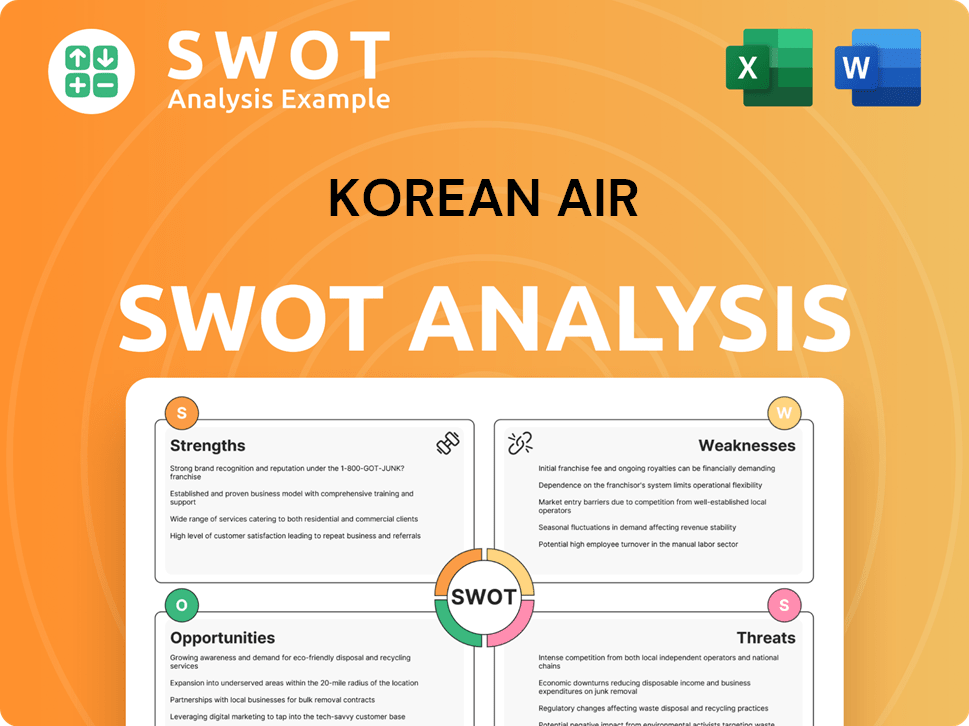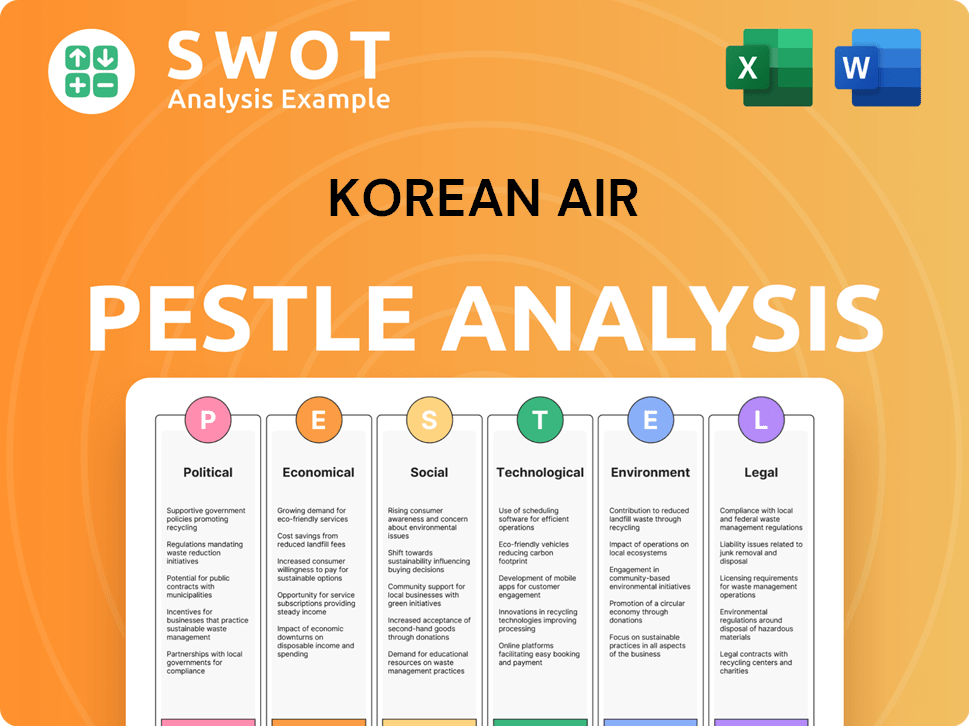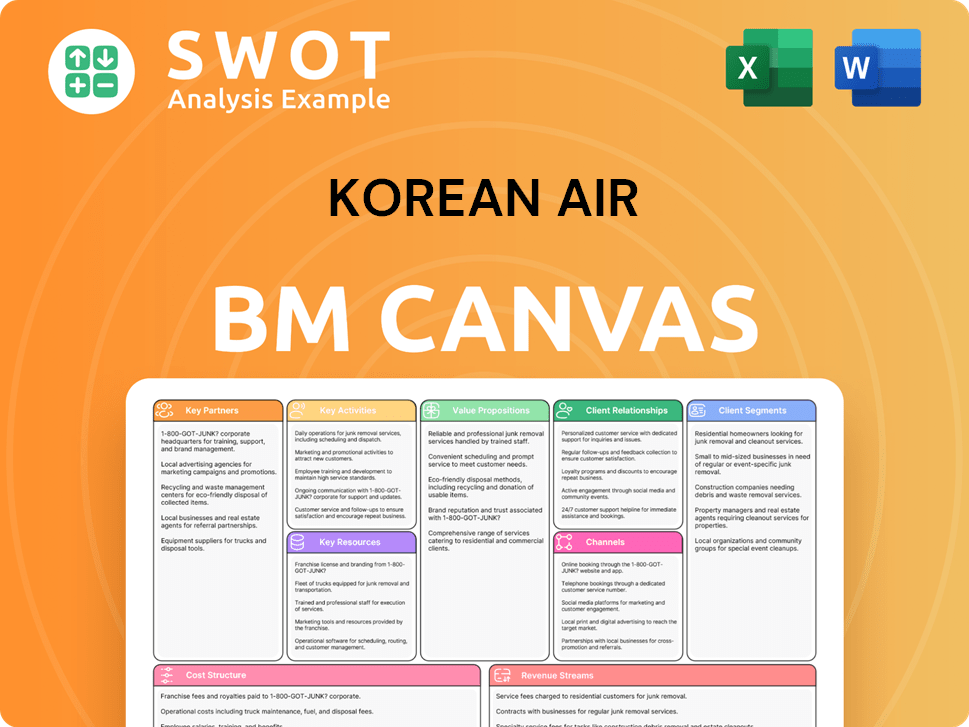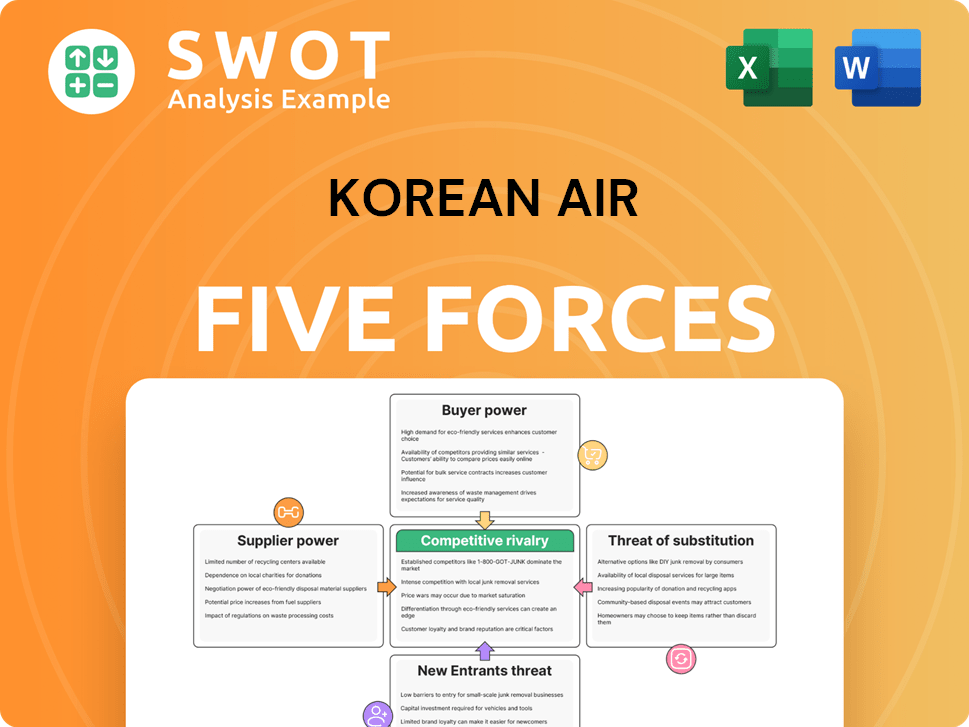Korean Air Bundle
Who Really Calls the Shots at Korean Air?
Understanding the intricacies of Korean Air SWOT Analysis is crucial, but have you ever wondered who truly steers this aviation giant? The recent acquisition of Asiana Airlines by Korean Air in December 2024 dramatically reshaped the South Korean aviation landscape, making it imperative to understand the airline's ownership structure. This consolidation, years in the making, has significantly altered Korean Air's market position and future prospects.

Delving into Korean Air ownership reveals a fascinating narrative of privatization, strategic acquisitions, and the influence of key stakeholders. From its origins as a state-owned enterprise to its current status as a global airline, the Korean Air parent company and the role of the Hanjin Group have been pivotal. This exploration will examine the evolution of Korean Air's history, its major shareholders, and the individuals who make up the Korean Air executives and Korean Air management team, providing a comprehensive view of who controls Korean Air and its strategic direction.
Who Founded Korean Air?
The story of modern-day Korean Air begins on March 1, 1969. This is when the Hanjin Group acquired the government-owned Korean Air Lines. This acquisition marked a pivotal moment, shaping the airline's future under private ownership.
The Hanjin Group, founded by Cho Choong-hoon in 1945 as Hanjin Transportation Co., stepped in to take over the struggling state-owned airline. The government, facing challenges with the existing airline, sought a private entity to revitalize it. This move set the stage for the Hanjin Group's significant role in the Target Market of Korean Air.
Cho Choong-hoon's vision was instrumental in transforming the airline. His leadership and strategic decisions were key to its early development. The airline was officially named KAL upon acquisition in March 1969.
The airline's roots trace back to June 1962, as Korean Air Lines, a state-owned entity. It was later acquired by the Hanjin Group.
The Hanjin Group, under Cho Choong-hoon, took over Korean Air Lines. This marked a shift from state to private ownership.
The state-owned airline faced issues like low demand and competition. This led to the government seeking private investors.
Cho Choong-hoon focused on cargo operations. This was a strategic move to build an Asian network.
At one point, the freight business accounted for approximately 40% of KAL's revenues. This highlights the early focus on cargo.
The Cho family's control over the Hanjin Group has been a defining feature. This has shaped the ownership structure of Korean Air.
The Hanjin Group became the Korean Air parent company. Early ownership was consolidated under the Hanjin Group. The strategic shift to cargo operations was a key decision.
- The initial acquisition of Korean Air Lines by the Hanjin Group in 1969.
- The Cho family's influence and control over the Hanjin Group.
- The strategic focus on cargo to build an Asian network.
- The role of Choong-hoon Cho in reshaping the airline.
Korean Air SWOT Analysis
- Complete SWOT Breakdown
- Fully Customizable
- Editable in Excel & Word
- Professional Formatting
- Investor-Ready Format

How Has Korean Air’s Ownership Changed Over Time?
The evolution of Korean Air ownership has been marked by significant shifts since its privatization. The airline is primarily controlled by Hanjin KAL Corporation, the holding company of the Hanjin Group, which transitioned to a holding company structure in 2013. This move reshaped the corporate landscape, influencing major shareholder dynamics and strategic partnerships.
Key events and the involvement of major stakeholders have consistently impacted the company's direction. These changes reflect broader industry trends and the strategic goals of Korean Air, including strengthening its position in the global aviation market and enhancing its operational capabilities.
| Shareholder | Stake as of Latest Data | Notes |
|---|---|---|
| Hanjin KAL | 26.13% (December 30, 2024) | Largest shareholder and parent company. |
| National Pension Service | 9.01% (March 13, 2025) | Significant institutional investor. |
| Delta Air Lines | 14.90% | Strategic partner and major shareholder in Hanjin KAL. |
| Korea Development Bank (KDB) | 10.58% (May 13, 2025) | State-owned bank, involved in financing. |
The Cho family, through Hanjin KAL, maintains substantial influence over Korean Air. Walter Cho, the current Chairman and CEO, represents the third generation of the family leading the airline. The Cho family's stake, along with the involvement of institutional and strategic investors, shapes the company's strategic direction. For more insights into the company's strategic moves, you can read about the Growth Strategy of Korean Air.
The ownership structure of Korean Air is complex, involving Hanjin KAL, institutional investors, and strategic partners. Delta Air Lines and the Korea Development Bank play crucial roles in the airline's financial and strategic landscape.
- Hanjin KAL is the primary controlling entity.
- Institutional investors like the National Pension Service hold significant stakes.
- Delta Air Lines is a key strategic partner and shareholder.
- The Cho family maintains significant influence.
Korean Air PESTLE Analysis
- Covers All 6 PESTLE Categories
- No Research Needed – Save Hours of Work
- Built by Experts, Trusted by Consultants
- Instant Download, Ready to Use
- 100% Editable, Fully Customizable

Who Sits on Korean Air’s Board?
The current board of directors of Korean Air operates under the control of Hanjin KAL. Walter Cho serves as the Chairman and CEO. While a complete list of board members and their specific roles for 2025 isn't fully available in the provided search results, the primary control rests with Hanjin KAL.
The governance structure is significantly influenced by the ownership concentration within Hanjin KAL and the Cho family. This structure grants them substantial control over the airline's operations and strategic decisions. The relationship between Korean Air and its parent company, Hanjin KAL, is central to understanding the airline's governance.
| Board Member | Title | Affiliation |
|---|---|---|
| Walter Cho | Chairman and CEO | Hanjin KAL |
| Unspecified | Director | Major Shareholder |
| Unspecified | Director | Independent Seat |
The voting structure generally follows a one-share-one-vote principle. However, the significant ownership held by Hanjin KAL and the Cho family gives them considerable influence. Hanjin KAL held a 26.13% stake in Korean Air as of December 30, 2024. Moreover, the Cho family, through their combined holdings and affiliated persons, controls Hanjin KAL, with Chairman Cho Won-tae and his affiliates holding 30.71% as of May 13, 2025.
The ownership structure of Korean Air is complex, with Hanjin KAL as the parent company and the Cho family holding significant influence. The Revenue Streams & Business Model of Korean Air provides further insights into the company's operations.
- Hanjin KAL's stake in Korean Air provides considerable voting power.
- The Cho family's control over Hanjin KAL is key to the airline's governance.
- External stakeholders can influence decision-making, as seen with government intervention.
- Past governance controversies have highlighted the importance of shareholder rights.
Korean Air Business Model Canvas
- Complete 9-Block Business Model Canvas
- Effortlessly Communicate Your Business Strategy
- Investor-Ready BMC Format
- 100% Editable and Customizable
- Clear and Structured Layout

What Recent Changes Have Shaped Korean Air’s Ownership Landscape?
Over the past few years, the ownership of Korean Air has been significantly shaped by its acquisition of Asiana Airlines. The deal, initially announced in November 2020, was finalized on December 12, 2024. This acquisition, valued at approximately USD 1.3 billion, positions Korean Air as the 12th largest airline globally by international capacity, with full integration of Asiana Airlines expected by January 2027. The merger also involves integrating low-cost carrier subsidiaries, including Jin Air, Air Busan, and Air Seoul, to establish a combined low-cost carrier focused on regional airports in Korea.
The consolidation within the South Korean aviation industry represents a key development in the Brief History of Korean Air. The parent company, Hanjin KAL, streamlined Jin Air's ownership directly to Korean Air in June 2022, in preparation for the larger merger. Furthermore, strategic investments from other airlines, such as Delta Air Lines, underscore a trend toward deeper alliances and cross-ownership in the global aviation sector.
| Ownership Structure | Details | As of |
|---|---|---|
| Hanjin KAL (Korean Air's Holding Company) | Cho Won-tae and Affiliates: 30.71% | May 13, 2025 |
| Hanjin KAL | Hoban Group: 18.46% | May 13, 2025 |
| Hanjin KAL | Korea Development Bank (KDB): 10.58% | Ongoing |
| Delta Air Lines (Hanjin KAL) | 14.90% | Ongoing |
The Cho family's control over Hanjin KAL and Korean Air remains central, with Chairman Cho Won-tae and his affiliates holding a combined 30.71% stake in Hanjin KAL as of May 13, 2025. However, the increasing presence of activist investors and other large shareholders indicates potential for management disputes. The state-run Korea Development Bank's continued stake also signifies the government's role in the industry. Looking ahead, Korean Air is focused on strengthening its competitiveness through fleet expansion, with firm orders for Boeing and Airbus aircraft, and enhancing shareholder value through a dividend policy aiming to return up to 30% of net profit to shareholders for fiscal years 2023 to 2025.
The Cho family, through Hanjin KAL, maintains significant control. Delta Air Lines is also a major shareholder.
The Asiana Airlines acquisition has reshaped the ownership landscape and the airline's global standing.
Partnerships, like the one with Delta Air Lines, are increasing, enhancing global reach.
Fleet expansion and shareholder value enhancement are key strategic priorities for Korean Air.
Korean Air Porter's Five Forces Analysis
- Covers All 5 Competitive Forces in Detail
- Structured for Consultants, Students, and Founders
- 100% Editable in Microsoft Word & Excel
- Instant Digital Download – Use Immediately
- Compatible with Mac & PC – Fully Unlocked

Related Blogs
- What are Mission Vision & Core Values of Korean Air Company?
- What is Competitive Landscape of Korean Air Company?
- What is Growth Strategy and Future Prospects of Korean Air Company?
- How Does Korean Air Company Work?
- What is Sales and Marketing Strategy of Korean Air Company?
- What is Brief History of Korean Air Company?
- What is Customer Demographics and Target Market of Korean Air Company?
Disclaimer
All information, articles, and product details provided on this website are for general informational and educational purposes only. We do not claim any ownership over, nor do we intend to infringe upon, any trademarks, copyrights, logos, brand names, or other intellectual property mentioned or depicted on this site. Such intellectual property remains the property of its respective owners, and any references here are made solely for identification or informational purposes, without implying any affiliation, endorsement, or partnership.
We make no representations or warranties, express or implied, regarding the accuracy, completeness, or suitability of any content or products presented. Nothing on this website should be construed as legal, tax, investment, financial, medical, or other professional advice. In addition, no part of this site—including articles or product references—constitutes a solicitation, recommendation, endorsement, advertisement, or offer to buy or sell any securities, franchises, or other financial instruments, particularly in jurisdictions where such activity would be unlawful.
All content is of a general nature and may not address the specific circumstances of any individual or entity. It is not a substitute for professional advice or services. Any actions you take based on the information provided here are strictly at your own risk. You accept full responsibility for any decisions or outcomes arising from your use of this website and agree to release us from any liability in connection with your use of, or reliance upon, the content or products found herein.